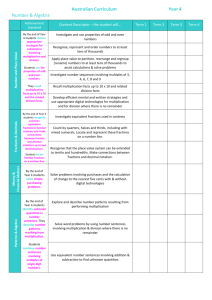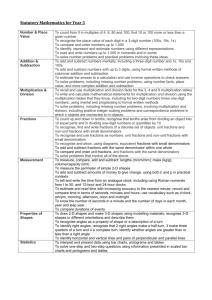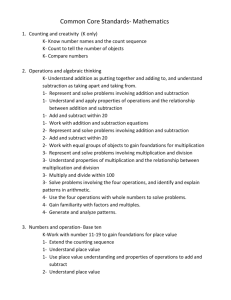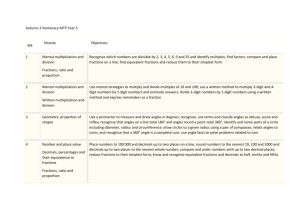Mathematics objectives year 3
advertisement
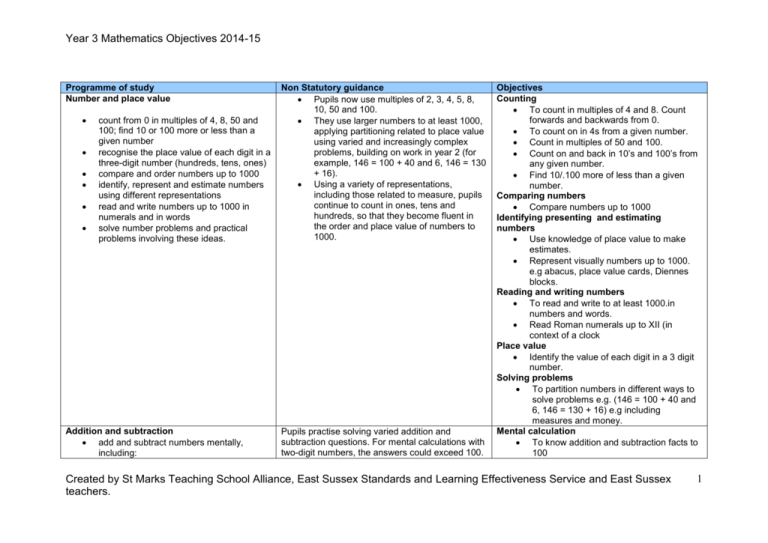
Year 3 Mathematics Objectives 2014-15 Programme of study Number and place value count from 0 in multiples of 4, 8, 50 and 100; find 10 or 100 more or less than a given number recognise the place value of each digit in a three-digit number (hundreds, tens, ones) compare and order numbers up to 1000 identify, represent and estimate numbers using different representations read and write numbers up to 1000 in numerals and in words solve number problems and practical problems involving these ideas. Addition and subtraction add and subtract numbers mentally, including: Non Statutory guidance Pupils now use multiples of 2, 3, 4, 5, 8, 10, 50 and 100. They use larger numbers to at least 1000, applying partitioning related to place value using varied and increasingly complex problems, building on work in year 2 (for example, 146 = 100 + 40 and 6, 146 = 130 + 16). Using a variety of representations, including those related to measure, pupils continue to count in ones, tens and hundreds, so that they become fluent in the order and place value of numbers to 1000. Pupils practise solving varied addition and subtraction questions. For mental calculations with two-digit numbers, the answers could exceed 100. Objectives Counting To count in multiples of 4 and 8. Count forwards and backwards from 0. To count on in 4s from a given number. Count in multiples of 50 and 100. Count on and back in 10’s and 100’s from any given number. Find 10/.100 more of less than a given number. Comparing numbers Compare numbers up to 1000 Identifying presenting and estimating numbers Use knowledge of place value to make estimates. Represent visually numbers up to 1000. e.g abacus, place value cards, Diennes blocks. Reading and writing numbers To read and write to at least 1000.in numbers and words. Read Roman numerals up to XII (in context of a clock Place value Identify the value of each digit in a 3 digit number. Solving problems To partition numbers in different ways to solve problems e.g. (146 = 100 + 40 and 6, 146 = 130 + 16) e.g including measures and money. Mental calculation To know addition and subtraction facts to 100 Created by St Marks Teaching School Alliance, East Sussex Standards and Learning Effectiveness Service and East Sussex teachers. 1 Year 3 Mathematics Objectives 2014-15 a three-digit number and ones a three-digit number and tens a three-digit number and hundreds add and subtract numbers with up to three digits, using formal written methods of columnar addition and subtraction estimate the answer to a calculation and use inverse operations to check answers solve problems, including missing number problems, using number facts, place value, and more complex addition and subtraction. Multiplication and division recall and use multiplication and division facts for the 3, 4 and 8 multiplication tables write and calculate mathematical statements for multiplication and division Pupils use their understanding of place value and partitioning, and practise using columnar addition and subtraction with increasingly large numbers up to three digits to become fluent (see Mathematics Appendix 1). Pupils continue to practise their mental recall of multiplication tables when they are calculating mathematical statements in order to improve fluency. Through doubling, they connect the 2, 4 and 8 multiplication tables. Pupils develop efficient mental methods, for example, using commutativity and associativity (for To use known number bonds e.g 17+ 3 = 20 to derive new facts e.g 37 + 13 = 50 To know sums and differences of multiple of 10 crossing 100 e.g 50+80, 120-90 To know addition doubles and halves for multiples of 10 to 100, e.g 90+90, half of 180 = 90 To add a single digit to a 3 digit number. To add tens to a 3 digit number. To add hundreds to a 3 digit number. To add several single digits. To add and subtract a 2 digit number to or from a multiple of 10. Add and subtract 2 digit numbers. To partition and recombine to add and subtract. To add near doubles 16+17 , 60+70 Written methods To add and subtract using columnar methods. (refer to school calculation policy) Inverse operations, estimating and checking answers To estimate answers and use inverse to check. Solving addition and subtraction problems To solve problems involving more than one step in a range of contexts. Multiplication and division facts To recall and use multiplication and division facts for the 3, 4 and 8 multiplication tables To make links between multiplication tables. To know doubles of multiples of 10 to 100 Created by St Marks Teaching School Alliance, East Sussex Standards and Learning Effectiveness Service and East Sussex teachers. 2 Year 3 Mathematics Objectives 2014-15 using the multiplication tables that they know, including for two-digit numbers times one-digit numbers, using mental and progressing to formal written methods solve problems, including missing number problems, involving multiplication and division, including positive integer scaling problems and correspondence problems in which n objects are connected to m objects. Fractions count up and down in tenths; recognise that tenths arise from dividing an object example, 4 × 12 × 5 = 4 × 5 × 12 = 20 × 12 = 240) and multiplication and division facts (for example, using 3 × 2 = 6, 6 ÷ 3 = 2 and 2 = 6 ÷ 3) to derive related facts (for example, 30 × 2 = 60, 60 ÷ 3 = 20 and 20 = 60 ÷ 3). Pupils develop reliable written methods for multiplication and division, starting with calculations of two-digit numbers by one-digit numbers and progressing to the formal written methods of short multiplication and division. Pupils solve simple problems in contexts, deciding which of the four operations to use and why. These include measuring and scaling contexts, (for example, four times as high, eight times as long etc.) and correspondence problems in which m objects are connected to n objects (for example, 3 hats and 4 coats, how many different outfits?; 12 sweets shared equally between 4 children; 4 cakes shared equally between 8 children). Pupils connect tenths to place value, decimal measures and to division by 10. They begin to understand unit and non-unit e.g. double 90, and corresponding halves Mental calculation To multiply and divide by 10 using zero as a place holder To know that multiplication can be done in any order but division can not To know that multiplication is the inverse of division To partition into tens and ones to multiply a two digit number by a one digit To multiply and divide two digit by one digit numbers using a written method and supported by equipment (refer to school calculation policy) Written methods To use short written methods for multiplying and dividing. Inverse operations, estimating and checking answers To use patterns in tables to solve problems and check answers. Estimate answers and use inverse to check. Solving problems To solve problems involving scaling up or down. To solve problems, including missing number problems, using number facts, place value and multiplication and division in a range of contexts. To choose when to multiply or divide to solve problems. Counting in fractional amounts To count on and back in unit fractions e.g tenths. Created by St Marks Teaching School Alliance, East Sussex Standards and Learning Effectiveness Service and East Sussex teachers. 3 Year 3 Mathematics Objectives 2014-15 into 10 equal parts and in dividing onedigit numbers or quantities by 10 recognise, find and write fractions of a discrete set of objects: unit fractions and non-unit fractions with small denominators recognise and use fractions as numbers: unit fractions and non-unit fractions with small denominators recognise and show, using diagrams, equivalent fractions with small denominators add and subtract fractions with the same denominator within one whole [for example 5/7 + 1/7 compare and order unit fractions, and fractions with the same denominators solve problems that involve all of the above. Measurement measure, compare, add and subtract: lengths (m/cm/mm); mass (kg/g); fractions as numbers on the number line, and deduce relations between them, such as size and equivalence. They should go beyond the [0, 1] interval, including relating this to measure. Pupils understand the relation between unit fractions as operators (fractions of), and division by integers. They continue to recognise fractions in the context of parts of a whole, numbers, measurements, a shape, and unit fractions as a division of a quantity. Pupils practise adding and subtracting fractions with the same denominator through a variety of increasingly complex problems to improve fluency. Pupils continue to measure using the appropriate tools and units, progressing to using a wider range of measures, including comparing and using mixed Recognising fractions To recognise 1/10 as one tenth, and know that it means one whole divided into 10 equal parts. To read and begin to write: part, fraction, one whole, one half, one quarter, three quarters, one third, two thirds, one tenth…. To find fractions of quantities. To find half of each of the numbers to 30 To know 1/10 of 20, ¾ of 20 …… Comparing fractions Compare unit fractions with the same denomination. To order fractions on a number line with the same denominator e.g. 2/6 3/6 5/6 Equivalence To represent relationships between fractions e.g one half is equivalent to 5/10 or 5 children out of a group of 10. To position simple fractions on a number line e.g. make a line to 10 showing whole, half and quarter numbers. Adding and subtracting fractions To add or subtract fractions with the same denominator e.g. 3/7 + 2/7 = 5/7 reminding children that the denominator stays the same. Solving problems To solve problems involving fractions in a range of contexts. Comparing and estimating Compare measures using simple scaling e.g twice as much, half as long, 3 times Created by St Marks Teaching School Alliance, East Sussex Standards and Learning Effectiveness Service and East Sussex teachers. 4 Year 3 Mathematics Objectives 2014-15 volume/capacity (l/ml) -D shapes give change, using both £ and p in practical contexts clock, including using Roman numerals from I to XII, and 12-hour and 24-hour clocks accuracy to the nearest minute; record and compare time in terms of seconds, minutes and hours; use vocabulary such as o’clock, a.m./p.m., morning, afternoon, noon and midnight nds in a minute and the number of days in each month, year and leap year example to calculate the time taken by particular events or tasks]. units (for example, 1 kg and 200g) and simple equivalents of mixed units (for example, 5m = 500cm). The comparison of measures includes simple scaling by integers (for example, a given quantity or measure is twice as long or five times as high) and this connects to multiplication. Pupils continue to become fluent in recognising the value of coins, by adding and subtracting amounts, including mixed units, and giving change using manageable amounts. They record £ and p separately. The decimal recording of money is introduced formally in year 4. Pupils use both analogue and digital 12-hour clocks and record their times. In this way they become fluent in and prepared for using digital 24hour clocks in year 4. more. Compare duration of events estimate and read time with increasing accuracy to the nearest minute; record and compare time in terms of seconds, minutes, hours and o’clock; use vocabulary such as a.m./p.m., morning, afternoon, noon and midnight Measuring and calculating To add and subtract: lengths (m/cm/mm); mass (kg/g); volume/capacity (l/ml) Measure lengths (m/cm/mm); mass (kg/g) volume/capacity (l/ml) To understand simple equivalence e.g.1m = 100 cm To measure and calculate perimeter of simple 2D shapes To suggest suitable units to measure or estimate. To order measures. To choose from a range of measuring equipment e.g. rulers, tapes, scales, jugs, beakers To read a scale to the nearest marked division To record estimates and measurements using a mix of units e.g. ‘three metres and twenty centimetres’’ three kilograms and five hundred grams’ or three and a half kilograms’. To calculate change using manageable amounts. Record answers as £ and p Time and money To know the relationship between units of time. Created by St Marks Teaching School Alliance, East Sussex Standards and Learning Effectiveness Service and East Sussex teachers. 5 Year 3 Mathematics Objectives 2014-15 Geometry draw 2-D shapes and make 3-D shapes using modelling materials; recognise 3-D shapes in different orientations and describe them recognise angles as a property of shape or a description of a turn identify right angles, recognise that two right angles make a half-turn, three make three quarters of a turn and four a complete turn; identify whether angles are greater than or less than a right angle identify horizontal and vertical lines and pairs of perpendicular and parallel lines. Pupils’ knowledge of the properties of shapes is extended at this stage to symmetrical and nonsymmetrical polygons and polyhedra. Pupils extend their use of the properties of shapes. They should be able to describe the properties of 2-D and 3-D shapes using accurate language, including lengths of lines and acute and obtuse for angles greater or lesser than a right angle. Pupils connect decimals and rounding to drawing and measuring straight lines in centimetres, in a variety of contexts. Read the time to 5 minutes and nearest minute on a digital clock and analogue clock e.g. 8.35 or 35mins past 8 or 25mins to 9. To calculate and compare the duration of events. To read Roman numerals up to XII Use am and pm to read time. Converting know the number of seconds in a minute and the number of days in each month, year and leap year Solving problems Solve problems involving measures, money and time in a range of contexts. Drawing and constructing To draw shapes accurately (sides drawn to the nearest cm) To use precise vocabulary related to properties of shapes. To construct 3D shapes draw 2-D shapes and make 3-D shapes (using modelling materials) Recognise 3-D shapes in different orientations and describe them To indentify reflective symmetry in 2D and 3D shapes. Angles, turns and lines To recognise angles as properties of shapes and as a description of turn. To identify angles which are more than or less than a right angle. Compare angles with right angles using accurate vocabulary. To find right angles. Created by St Marks Teaching School Alliance, East Sussex Standards and Learning Effectiveness Service and East Sussex teachers. 6 Year 3 Mathematics Objectives 2014-15 To recognise that two right angles make a half-turn, three make three quarters of a turn and four a complete turn. To identify horizontal and vertical lines and pairs of perpendicular and parallel lines. Solving problems Solve problems involving geometry, in a range of contexts. Statistics interpret and present data using bar charts, pictograms and tables -step and two-step questions [for example, ‘How many more?’ and ‘How many fewer?’] using information presented in scaled bar charts and pictograms and tables. Pupils understand and use simple scales (for example, 2, 5, 10 units per cm) in pictograms and bar charts with increasing accuracy. They continue to interpret data presented in many contexts. Interpreting, constructing and presenting data To answer a question by identifying what data to collect. To collect data choosing appropriate methods. To present data choosing appropriate representation. To find answers to questions and suggest reasons, using information from bar charts, pictograms and tables. To understand and use simple scales. To develop own line of enquiry. To solve one and two step problems involving using barcharts, pictograms and tables. Created by St Marks Teaching School Alliance, East Sussex Standards and Learning Effectiveness Service and East Sussex teachers. 7

